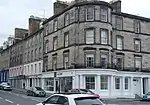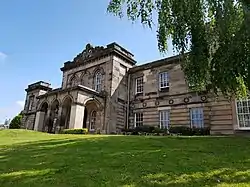William Macdonald Mackenzie
William Macdonald Mackenzie (20 July 1797 – 25 February 1856) was a Scottish architect, prominent in the first half of the 19th century.[1] He designed several notable buildings in Scotland, mostly manses and church buildings.
William Mackenzie | |
|---|---|
| Born | William Macdonald Mackenzie 20 July 1797 St Martins, Perth and Kinross, Scotland |
| Died | 25 February 1856 (aged 58) Perth, Scotland |
| Occupation | Architect |
Early life
Mackenzie was born in 1797 in St Martins, a parish about 4.3 miles (6.9 km) north-northeast of Perth, the second son of Alexander Mackenzie, an architect-builder, and his wife Janet Davidson. (In 1806, his father was listed as the owner of the land on which the Witches' Stone stands.[2] The stone marks the location where Macbeth meets with two witches in William Shakespeare's tragedy.)[3][4]
His four younger brothers were John (born 1799), Alexander (born 1803), David (born 1805) and Thomas (born 1814). He also had a sister, Matilda.[1] His father died in 1827.[1]
Career
Mackenzie practiced out of 14 Charlotte Street in 1837 and 5 George Street in 1841. From 1848, however, he appears to have been based at his house on Byerswell (now Bowerswell) Road in Bridgend.[1]
He was Perth's City Architect until his death, after which he was succeeded by Andrew Heiton and his father.[5]
Selected notable works
- St Leonard's Bank, Perth (plots laid out for feuing, 1828)
- 20 Charlotte Street, Perth (1830)[1]
- St Leonard's Parish Church, Perth (1836)[5]
- A. K. Bell Library (original central section and lodge), Perth (1836–1838)[6]
- Binnhill Tower, Kinfauns (1839)[7]
- Manse of Kinfauns (1840)[5]
- Clunie Church (1840)[5]
 20 Charlotte Street
20 Charlotte Street A.K. Bell Library
A.K. Bell Library_(geograph_5611335).jpg.webp) Binnhill Tower
Binnhill Tower
Personal life
Mackenzie married Jean Davidson, his cousin, around 1824. They had at five children: three sons and two daughters. Second son William (1826–1864), trained as a civil engineer. His other children were David, James and Alexander, and his daughters Jane Ann and Jessie.[1]
He died on 25 February, 1856, aged 58, and was buried in Perth's Greyfriars Burial Ground.[5] His family moved to Liverpool after his death, then returned to Scotland and lived in Dundee with Mackenzie's brother David.[1]
References
- William Macdonald Mackenzie - Dictionary of Scottish Architects
- The Monthly Mirror: Reflecting Men and Manners : with Strictures on Their Epitome, the Stage · Volume 22. 1806. p. 265.
- Historic Scenes in Perthshire, William Marshall, 1880 (p. 250)
- "Witches' Stone, St Martins | Canmore". canmore.org.uk. Retrieved 20 December 2022.
- Ordnance Gazetteer of Scotland: A Graphic and Accurate Description of Every Place in Scotland, Francis Hindes Groome (1901)
- York Place, A K Bell Library including Boundary Wall to York Place – Historic Environment Scotland
- A Topographical Dictionary of Scotland, Samuel Lewis (1846), p. 73